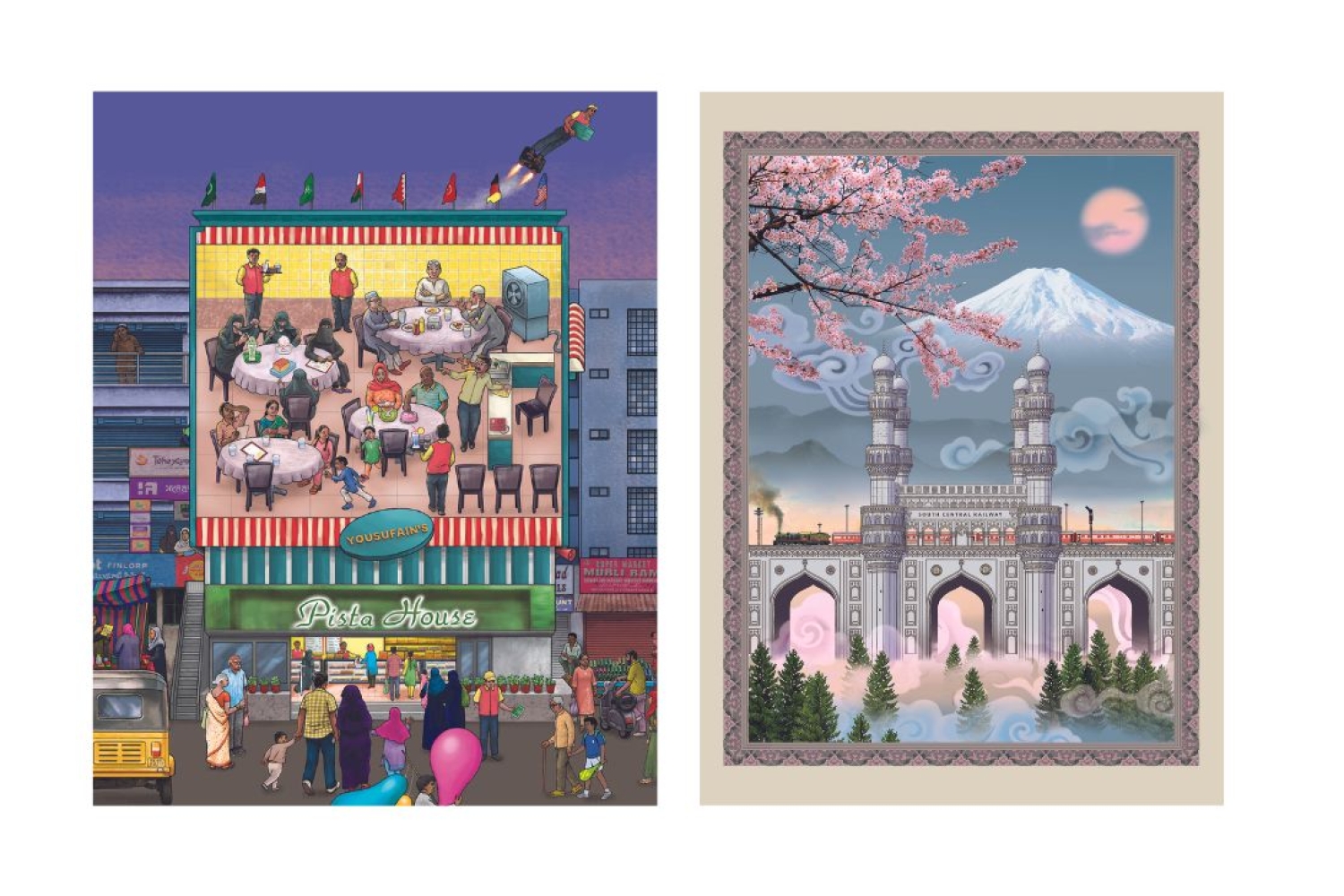
Pista House (left) | Charminar II (right)

Pista House (left) | Charminar II (right)
​Credited with creating the first-ever Indian graphic novel, artist Orijit Sen started working on his solo exhibition seven years ago. He explores the question of Hyderabadi identity — the outsider-insider gaze, the history that informs the present, the festivals, the everyday life and the symbol of Charminar. This exhibition acts as a tribute to the city that made him pursue art. To know more about the behind-the-scenes of his exhibition, we talked to Orijit on his journey of crafting this art series.
Tell us why you chose to paint the streets of Hyderabad.
I spent my teenage years in Hyderabad, which was in the mid to late 70s. It was a sort of formative time of my life. I always have carried good memories of Hyderabad. This was also the city from where I decided to become an artist. In some ways, I always had this sort of connection. But the immediate or rather the more definite provocation was because of Prshant Lahoti, who runs the Kalakriti Art Gallery. He contacted me and said it would be great if I could think of doing something on Hyderabad. I met him, we discussed it and he agreed to sponsor some part of the project. So that's how we got started.
Is this series also an attempt to preserve history?
In my work, I like to engage with spaces and places — explore what makes a place a place, what makes Hyderabad Hyderabad, and what makes a Hyderabadi a Hyderabadi? Does it have to do only with your origins? I think the question of identity is quite mixed up and interesting. I wanted to explore this notion of the Hyderabadi identity or where that comes from. So yes, preserving history or documenting history was part of it, but that's not the main thing. I mean, I'm always interested in the present-day culture of a place and of course, history plays a role in forming the present. It's not history per se but how it plays out in the present that interests me. I chose to mostly concentrate on my research and studies around the old city — partly because the rest of Hyderabad had changed by the time I came back to start this project which was a few years ago. It had changed completely, I couldn't recognize the places I used to hang out. Most of the shops and establishments that I was familiar with were gone. The many landmarks had changed. There was a whole different feel, it felt much bigger and much more crowded. But the old city remained the same. It was just like I remember it. And it was full of life. I was looking at practices like the people who do the work, food process practices like haleem and all of that so I was really looking at the living culture of the old city.
You have painted the Charminar in various different settings, one of which also includes a Japanese background. What inspired you to make such visuals?
When I first started on this project, one of the first pieces that I made was for the Kochi Biennale in 2017. It was a big glass Charminar which was lit from within. It was part of an interactive puzzle where you could play with the pieces of images around the Charminar. There was a big window, I decided that was a nice spot for the Charminar model. I placed it and it's about four feet high. It's a large-ish model. The moment I placed it there and I stepped back to look at it, I saw the ocean and a ship passing by through the arch of the model.
I was struck by that image because I would never have thought of Charminar as something in the middle of the ocean. I started thinking about that, I started drawing the Charminar with different backgrounds and trying to see how that affects the meaning of the monument. The monument has been used repeatedly to symbolize a lot of things about Hyderabad. It's been used for advertising, and commercial purposes, even like the Charminar was on cigarettes. The Charminar has been appropriated for commercial as well as government purposes. I was kind of commenting ironically about the fact that the Charminar is an element by itself which is displaced from its context. That's when I started drawing these different things that inspired me and putting Charminar out in a different context.
You chose a Dakhini title for the exhibition. Tell us about what it means, why you chose the title and what it has to entail.
I mean I wanted to bring in the Dakhini language because I think it's very much at the heart of what Hyderabadi identity is all about. To me, in fact, that language is what unites so many people, historically. Many people have come to Hyderabad from different places. There are Iranis, Turks, Yemenis and Baniyas from Marwar.
It is at the heart of the expression of the city. Unfortunately, in my medium, there is no scope for sounds. If I were to make a film about Hyderabad, I would definitely focus a lot on the Dakhini language but I could still bring it in certain ways and one of them was through the title.
Your artworks are often looked at as a project of cartography, how do you bring in the essence of maps in your paintings?
My interests and cartography are definitely an important part of it. My father was a cartographer. So I sort of understood much more about miniature painting. I got to develop a style that sort of brought together comics, miniature paintings and maps. So it all became like a kind of coming together of many different threads.
Words Paridhi Badgotri
Date 07.09.2023